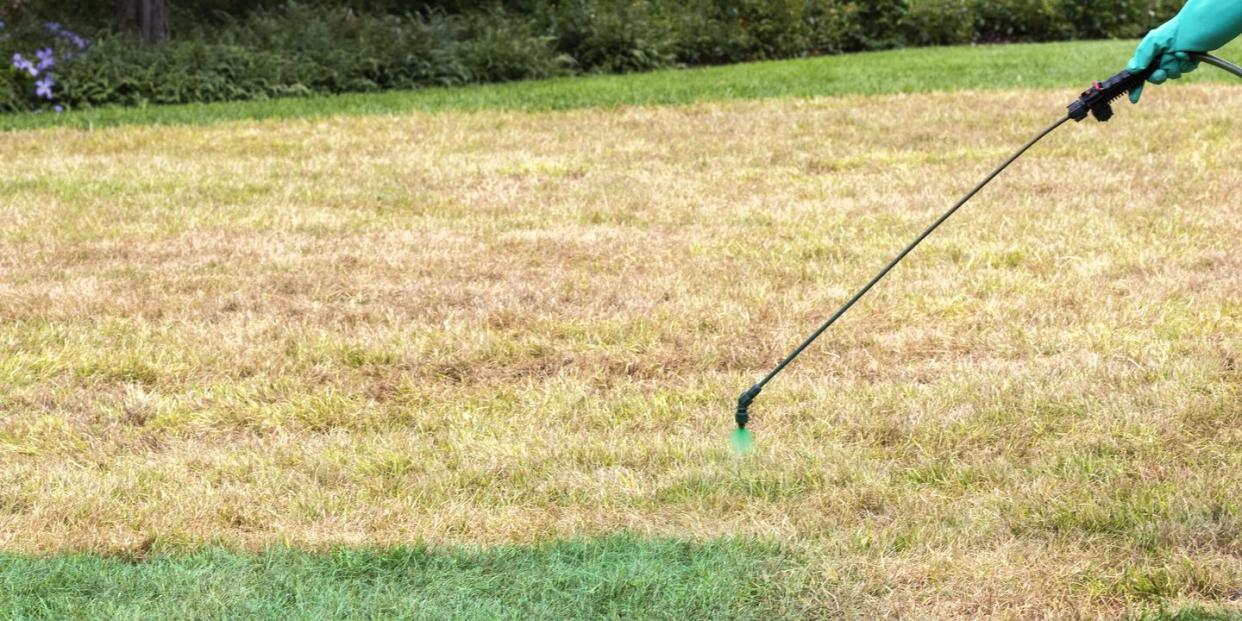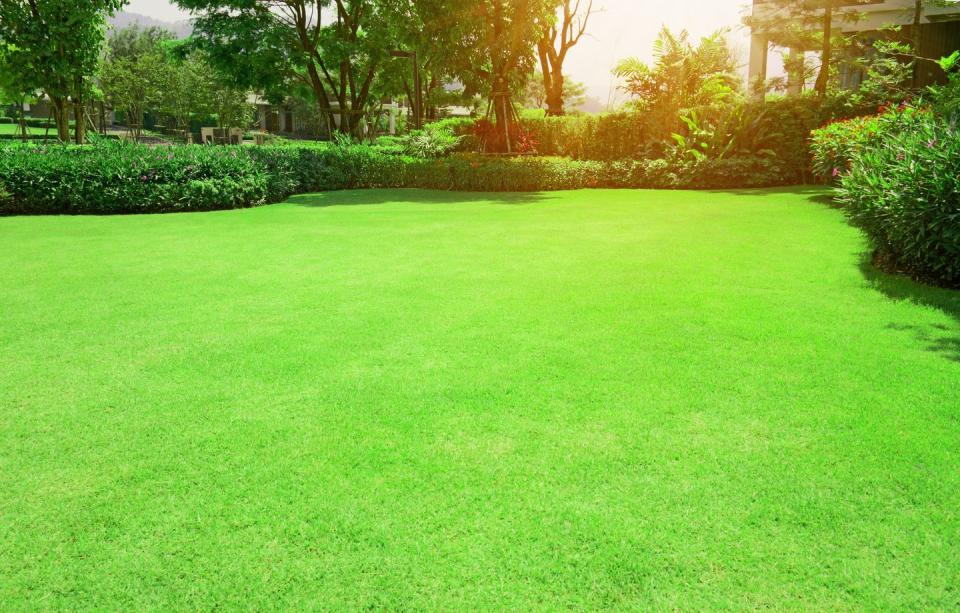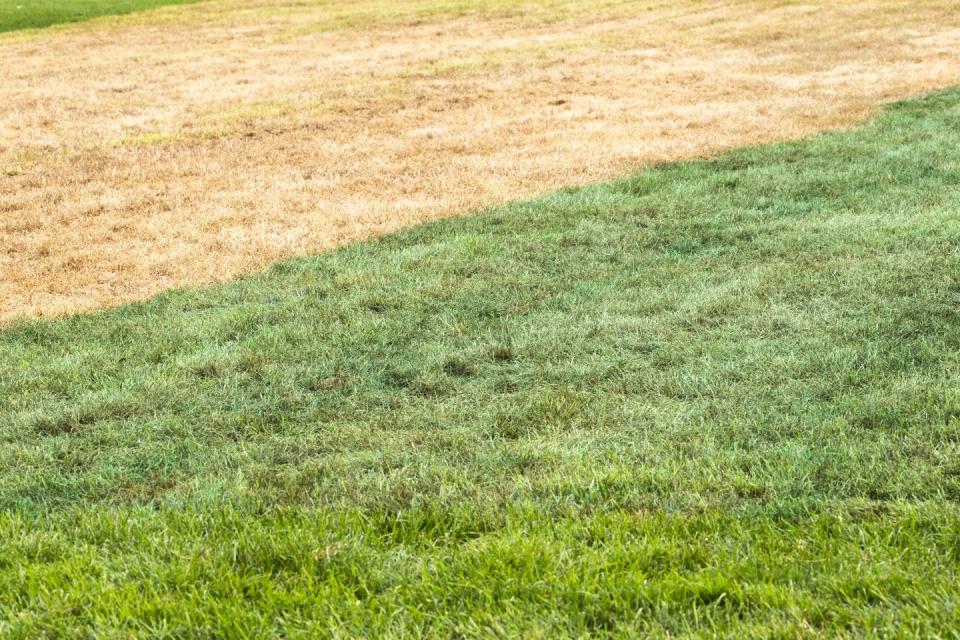Should You Spray Paint Your Lawn?

There's no denying that a beautiful lawn requires patience, time and energy. If you've ever looked at your less-than-perfect grass and wondered if there's a quick fix, we may be able to help, at least temporarily! If you've got a brown, sad-looking lawn, turf colorants—which people sometimes call "grass spray paint,"—are a fast, easy, and safe way to give it an attractive green color, at least temporarily.
These products, which are sprayed on the grass surface, have been gaining popularity for decades. "They were first used on athletic fields and golf courses," says Clint Waltz, PhD, extension turf grass specialist at the University of Georgia. "They're most often used on warm season grasses, such as bermuda grass, centipede grass, and zoysia grass, which lose their color and go brown when dormant."
In the past, warm season grasses on properties such as golf courses were overseeded with cool-season grasses in order to maintain a green playing surface during winter. But transitioning these fields back to warm season grasses in the spring still proved challenging, says Waltz. That's where colorants came in handy. Their popularity grew, and now, colorants are accepted as a less expensive, aesthetically-appealing alternative for commercial turf.

Homeowner soon took notice, and use of the products on private lawns has been on the rise in recent years. You don't need to have one of the warm season grasses named above to use them. While turf colorant is used mostly for dormant warm season grasses, it can work in colder climates as well. A turf colorant can be used on cool-season grasses during drought or to reduce mottled appearances from winter or summer stress, according to studies done by researchers at North Carolina State University.
Tempted to try it before that big Fourth of July party? Here's what else you need to know about turf grass colorant:
Do Turf Colorants Hurt the Grass?
Not if you choose the right option. (For recommendations, scroll down to our gallery.) Older products were difficult to apply and didn't look natural, but the technology available to homeowners has improved in recent years, with pigments and binders, which cause it to adhere to the leaf blades, made from natural ingredients. "New products are not biologically harmful to the plant," says Waltz.
In some cases, colorants actually may be beneficial to dormant warm season grasses. Colorant increases surface temperature, which may help dormant warm-season grasses green up faster in the spring. Research has found that colorants may reduce the winter dormancy period by as much as two to three weeks.
How Long Does Painted Grass Last?
It depends on many factors, such as how uniformly it was applied, the air temperature when applied, the type of ingredients in the product, and how much usage or wear and tear the grass is receiving. On grass that's completely dormant, you'll generally need to reapply after 4 to 6 weeks to maintain its appearance, says Waltz. That means several applications will be required throughout the winter. Color applied to cool season grasses, such as during drought stress in summer, will also need additional applications as it the old grass grows out.
The timing of your first application may affect how long color lasts. Research has found that color may last longer on semi-dormant turf. That means it’s better to apply color to turf that's not yet straw-brown but still retains some green.
Finally, the many different products available vary in color, longevity, and ease of application, so you may need to do some experimenting to find a product that you like. And while you may love the color and final appearance of one product, another person may not like it at all—which reinforces the idea that beauty is in the eye of the beholder!

Is It Easy to Spray Paint Your Grass?
While early products for home use were difficult to apply and looked fake, new formulations have been introduced that make it easier to get a more natural appearance. But know that if you aren't fastidious and willing to take your time, painting grass may not be the right DIY job for you.
The biggest issues to look out for—or to consider bringing in a professional? Colorants will stain surfaces such as sidewalks, house foundations, and curbs. Coloring grass is just like painting anything: If you go over the same area again and again, and skip other spots, you'll end up with a splotchy mess. Fortunately, the mess won't last because the grass will grow out eventually, says Waltz.
Finally, if your grass is riddled with crabgrass and other weeds, a colorant won't solve your lawn's problems. Turf colorants can make the grass greener, but it’s not going to fix any underlying disease, pest, or nutrient issues, and by spraying as a cosmetic fix, you could be masking a problem, says Waltz.
As with any product, read the reviews (especially any negative ones), comparison shop, and follow the instructions exactly. This isn't a product you should guess about how to use!

How Do You Spray Paint Your Lawn?
If you do decide to color your grass, here are some application tips from Brad Driggers, national sales representative for Endurant Turf Colorants:
Apply color before grass is straw-brown. The better your lawn looks overall before you paint it, the better it looks after.
Protect hard surfaces. The colorant will soak into porous materials such as concrete or wood, so cover sidewalks, pavers, house foundations, driveways, and curbs with plywood or cardboard. Also, wear old clothes and boots while spraying to prevent staining.
Follow the manufacturer's mix ratio. The package instructions will tell you the ratio of colorant to water you should use. "If you don’t follow the recommended ratio, that reduces the product's ability to adhere and its longevity," says Driggers
Use a pump or backpack sprayer. Either type will get the job done, but a backpack sprayer will provide a steady, consistent spray so you don’t have to keep pumping it up.
Choose the cone tip. A conical tip with adjustable stream nozzle is the best type to apply the product uniformly, says Driggers.
Practice in a small area. Try it out in a part of your lawn that's less visible, so you can get a feel for the sprayer. Then, start in a back corner of the lawn, working your way forward so you have a clear path and don't have to walk on the area you just sprayed.
Apply product by moving your wrist in a slightly circular motion as you walk at a steady pace. "This allows you to hit the leaf tips from several different directions," says Driggers.
Avoid spraying if heavy rain is forecast within 8 hours. You don't want all your hard work to be washed away.
Stay off the grass until it's dry. This typically takes several hours, depending on environmental conditions. For example, if it's a humid day, it will take longer to dry.
You Might Also Like
